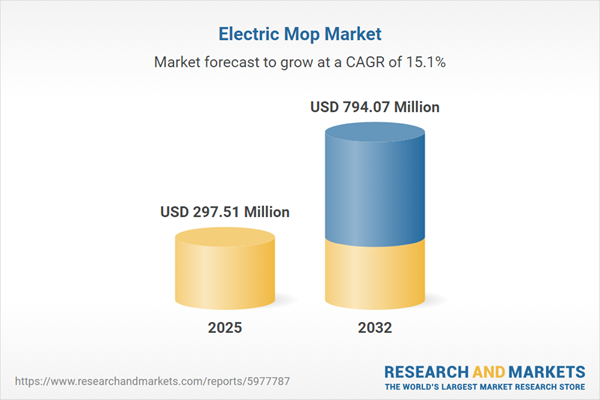Speak directly to the analyst to clarify any post sales queries you may have.
The electric mop market is transforming facility care, enabling senior leaders to drive higher compliance, efficiency, and innovation across managed environments. As organizations prioritize advanced floor care solutions, intelligent cleaning technology is becoming a core tool for supporting operational standards and workplace performance.
Market Snapshot: Electric Mop Market Size and Growth
In 2024, the electric mop market has achieved a valuation of USD 258.48 million, advancing at a compound annual growth rate of 15.06%. This robust growth reflects increasing demand for automated and intelligent floor care in both commercial and residential settings. Enterprises are moving quickly to adopt these solutions, motivated by the need to reach higher cleaning standards, reduce dependence on manual processes, and maintain a decisive operational edge through smart technology adoption and early mover advantages.
Scope & Segmentation: Electric Mop Market Opportunities
Thorough segmentation insight enables facility executives and procurement teams to select the right electric mop solutions that support evolving business requirements. Market opportunities can be understood across the following dimensions:
- Distribution Channels: A broad range of sourcing solutions is available through offline retailers, specialist outlets, supermarkets, hypermarkets, direct-from-manufacturer procurement, and e-commerce platforms. This diversity meets the needs of organizations seeking agility in supply strategies or looking to manage potential risks in the supply chain.
- Product Types: The market features corded, cordless, and robotic mops designed for specific facility layouts and cleaning environments. Each type supports different levels of operational intensity, from hands-on control to autonomous systems for continuous or unattended use.
- End Users: Segments include education, healthcare, hospitality, retail, and residential homeowners, each prioritizing different aspects such as durability, user safety, and compliance with strict hygiene protocols.
- Battery Types: Lead acid, nickel-metal hydride, and lithium-ion options give buying teams flexibility to align mop performance with sustainability objectives and power demands, addressing both routine and intensive cleaning cycles.
- Applications: Available technologies support dry cleaning, wet mopping, and polishing for a broad spectrum of hygiene and safety standards, ensuring solutions can be tailored to high-traffic, sensitive, or diverse facility requirements.
- Price Tiers: Economy, mid-range, and premium options are accessible, allowing organizations to select solutions matched to operational budgets and value expectations.
- Regions: Market uptake varies by region—Americas, Europe, Middle East, Africa, and Asia-Pacific—based on factors like technology readiness, logistics infrastructure, and regulatory policy, making regional strategy critical for competitive advantage.
- Leading Companies: Key industry participants include iRobot Corporation, Ecovacs Robotics Co., Ltd., Roborock Technology, SharkNinja Operating LLC, Bissell, Kärcher, Tineco Intelligent Technology, ILIFE Robotics, Stanley Black & Decker, and TTI Floor Care North America. These organizations deliver portfolios tailored by application, industry, and user preference.
Key Takeaways: Strategic Insights for Senior Decision-Makers
- Battery innovation and advanced robotics are facilitating greater automation, streamlining floor care operations, and supporting large-scale facility efficiency with reduced manual oversight.
- Diverse product sources—including direct manufacturing and online procurement—arm organizations with adaptability for addressing changes in market supply or demand.
- Modern electric mop designs emphasize intelligent controls and ergonomics, ensuring teams can maintain compliance with health and safety regulations while easing operational training requirements.
- Flexible regional sourcing enables enterprises to stay resilient in the face of shifting supply chain or regulatory landscapes, maintaining continuity in critical facility operations.
- Commitment to sustainability is evident through recyclable components and modular product structures, enhancing alignment with organizational environmental and governance goals.
Tariff Impact: Navigating Policy and Supply Chain Complexity
Recent tariff changes in the United States are prompting manufacturers and suppliers serving the electric mop market to localize production, invest in manufacturing automation, and apply stronger inventory tracking. These strategic adjustments are designed to maintain competitiveness while supporting broader adoption of advanced cleaning solutions across all end-user groups.
Methodology & Data Sources
This report synthesizes insights from executive-level interviews, direct field studies, reviews of public records and patents, structured benchmarking, and analysis of industry-specific datasets. The multi-source approach ensures actionable intelligence and robust support for decision-making at the senior management level.
Why This Report Matters for the Electric Mop Market
- Presents clear market segmentation and regional perspectives, empowering leaders to anticipate evolving trends and proactively mitigate supply and operational risks.
- Arms decision-makers with guidance for supply chain optimization and ensuring that technology implementation supports compliance and standardization goals within facilities.
- Promotes sustainable procurement strategies, supporting alignment with regulatory changes and reinforcing long-term organizational sustainability objectives.
Conclusion
This analysis empowers executives to lead advancements in procurement, elevate facility quality, and make informed choices that secure growth in the evolving electric mop technology sector.
Additional Product Information:
- Purchase of this report includes 1 year online access with quarterly updates.
- This report can be updated on request. Please contact our Customer Experience team using the Ask a Question widget on our website.
Table of Contents
3. Executive Summary
4. Market Overview
7. Cumulative Impact of Artificial Intelligence 2025
Companies Mentioned
The companies profiled in this Electric Mop market report include:- iRobot Corporation
- Ecovacs Robotics Co., Ltd.
- Roborock Technology Co., Ltd.
- SharkNinja Operating LLC
- Bissell, Inc.
- Kärcher GmbH & Co. KG
- Tineco Intelligent Technology Co., Ltd.
- ILIFE Robotics Co., Ltd.
- Stanley Black & Decker, Inc.
- TTI Floor Care North America, Inc.
Table Information
| Report Attribute | Details |
|---|---|
| No. of Pages | 181 |
| Published | October 2025 |
| Forecast Period | 2025 - 2032 |
| Estimated Market Value ( USD | $ 297.51 Million |
| Forecasted Market Value ( USD | $ 794.07 Million |
| Compound Annual Growth Rate | 15.0% |
| Regions Covered | Global |
| No. of Companies Mentioned | 11 |









